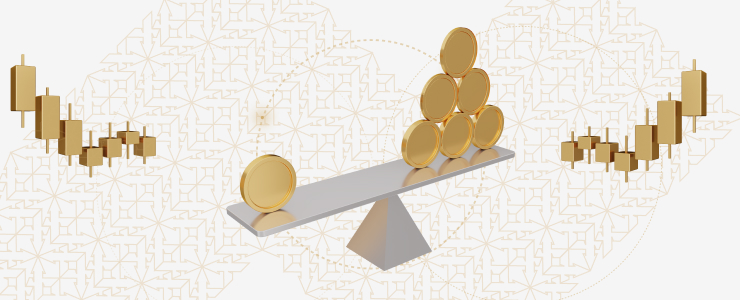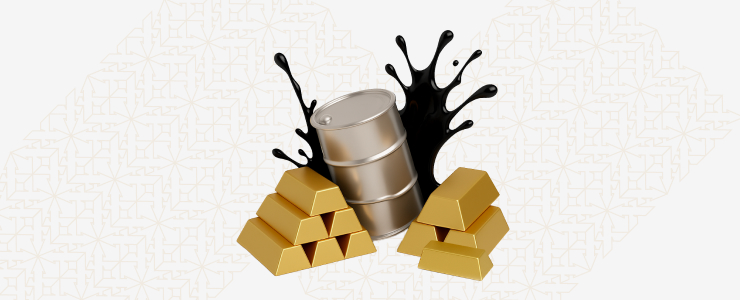Commodities are one of the five major traditional asset classes in CFD trading. The class contains goods taken from the earth. This means that, unlike most other asset classes, they are usable in everyday situations, and more importantly, expendable.
Even if you’ve never interacted with the commodities market, you’ve surely come in touch with commodities. For instance, since we can assume you’ve eaten bread, you’ve interacted with the wheat market. In that sense, it somewhat resembles the forex market, as it plays an active role in our everyday lives.
Also, similarly to forex, the portion that you use isn’t really comparable to commodities used in various industries. While you may fill up your gas tank with petrol, a company may fuel a shipping vessel, which burns literal tonnes of fuel per day.
Today, we’ll give you a rundown of the commodities market, focusing on explaining the different commodity categories.

What are commodities and why are they important?
Traditionally, we classify commodities into three categories: energies, metals, and agricultural commodities. While you can likely instinctively imagine some assets from each class, before we start listing them, let’s look at why this separation is important.
The first part is that different factors impact each of these asset groups. Commodities are tricky. They are, by nature, global assets, and tracking news is a difficult task for traders who want to get the most out of them. Simply put, there are so many supply and demand lines that following data may seem impossible at times.
That’s why segmenting them into at least three different groups is so important. It allows you to follow some big-picture factors that impact entire commodity segments, instead of viewing them individually. Following news for energies as a group is much simpler than following them for crude oil, coal and natural gas separately. It lets you form an idea of the context surrounding all of these assets, so you can more easily scope in and focus on your preferred one.
Additionally, it’s simply much more convenient. We always preach keeping your trading interface tidy as if you had a work desk. In this case, that would mean grouping and sorting these in your watchlist for easier navigation and more conscious control over your trading.
With that in mind, let’s start dissecting each category individually.
Metal Commodities
Industries use metals as a vital commodity in everything from heavy production to microchips. There’s a small subdivision in the metals category, splitting them into precious metals which have long been signs of luxury, and base metals which are vital production materials.
Precious metals
Precious metals are rare and naturally occurring. They are mostly resistant to oxidisation and corrosion. While the average person may think of them in the context of luxury items, like for instance jewellery, they also have industrial purposes.
Gold
Gold is the most traded precious metal on global markets. People have long viewed it as a symbol of opulence, valuing it for its lustre and rarity. On a practical side, it’s also highly conductive and resistant to corrosion, making it perfect for electronics. Traders consider it a safe haven asset. Investors may flock to it to avoid inflation and changes in currency prices. China, Australia, and Russia produce most of the world’s gold.
Silver
Silver has historically played second fiddle to gold, but people have long used it to craft luxury items. Thanks to its high conductivity and reflectiveness, manufacturers also use it in electronics and, more specifically, in solar panel construction. In trading, it serves a similar purpose, providing some protection against economic downturns.
Mexico, Peru, and China are the world’s top silver producers.
Base metals
Base metals are less rare and more prone to oxidation. However, they have other qualities, like pliability and durability, making them perfect for industrial use. It’s important to note that these metals are much more abundant than precious metals, so industries use them more widely even though they share similar qualities.
Copper
Copper’s excellent thermal and electrical conductivity explains why manufacturers most commonly use it in wiring. However, in more modern industries, copper has also become invaluable for renewables and EVs. Because of its prominence, analysts consider its price a global economic indicator.
Chile, Peru, and China are global leaders in Copper production.
Aluminium
Aluminium is highly resistant to corrosion and lightweight, seeing broad use in multiple industries. Manufacturers use it in vehicle production, containers, and construction. Traders actively trade it because of its importance across industries, and its price reflects the health of the industrial sector.
China, India, and Russia produce most of the world’s aluminium.
Energies
Energy commodities are essential for modern life. Electricity production, heating, transportation, and shipping are all highly dependent on energies. As such, many traders consider them an excellent safety asset, due to the fact that they remain crucial regardless of financial market performance.

Crude oil
Brent crude oil ranks as the most commonly traded and widely used energy commodity. This naturally occurring fossil fuel can be refined into various products. We use it as petrol for transportation and in petrochemicals to produce plastics, fertilizers, and more. Traders consider crude oil a global pricing standard and often use it to hedge against market volatility.
It’s mostly extracted in the US, Saudi Arabia, and Russia, and is most commonly used in the US and China.
Natural gas
Natural gas is also a fossil fuel, mostly comprised of methane. Its primary uses are in heating and electricity, powering turbines, industrial and residential heating systems, and acting as an energy resource for chemicals. It’s a seasonal asset, with weather conditions impacting the price significantly.
Natural gas is mostly produced in the US, Russia, and Iran, and expended by the US, EU, and China.
Agricultural commodities
Agricultural commodities (sometimes called agricultures) contain assets vital for global consumption. They are widely used, and sometimes separated from the previous two groups and called soft commodities.
Coffee
Coffee is one of the most consumed drinks worldwide. It’s a staple in daily diets and is bought and sold in massive quantities. It’s mostly produced in Brazil and Vietnam.
Corn
Corn has more various uses than coffee, although it’s also a key part of many diets. However, it also has a role in feeding livestock, and in biochemical production. The primary producers are the US, Brazil, and China.
Soybeans
Soybeans fulfill a similar role as corn, in that they also have dietary uses, feed livestock, and play a part in creating biodiesel. Soya beans are mostly harvested in the US and Brazil.
Live cattle
Live cattle are used to produce beef, a vital protein source in worldwide cuisines. Traders use live cattle as a haven asset, as food is a necessity. Most live cattle come from the US and Brazil, with the EU, China, and India also having notable supply lines.
Lean hogs
Similarly to live cattle, lean hogs are a vital part of global food production. They are used to create pork, a generally more accessible food in many areas. Leading lean hog producers are China, the US, and the EU.
And those are the primary assets from every commodity subgroup! Being a successful commodities trader requires a good understanding of the global economy and keeping a close eye on global events. However, if you master that, commodities can be very useful for your portfolio, traditionally showing very consistent performance.
Disclaimer:This information is not considered investment advice or an investment recommendation, but instead a marketing communication..


